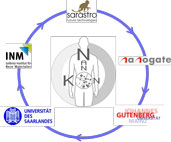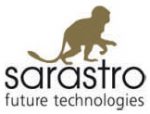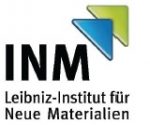
NanoKON – Systematic evaluation of health effects of nanoscale contrast agents
The NanoKon project was dedicated to assessing the health effects of orally administered nanoscale contrast agents. For that specific purpose, nanoparticles were produced and tested together with commercially available reference particles in numerous in vitro, in vivo, and in silico assays.
Within work package 1, the respective nanomaterials were thoroughly characterised and their specific properties e.g., ion release of toxically relevant species (Ba, Gd) in artificial gastric juice analysed. The changing conditions (pH, high ionic strength) were tolerated only insufficiently by most of the (commercially available and self-synthesised) particle systems causing agglomeration for the majority of the tested nanoparticles. In the course of the project different modifications of the nanoparticles’ surface were investigated with the objective of obtaining as stable as possible suspensions that are functional with regards to reproducibility.
Work packages 2 and 3 were dedicated to in vitro analyses of the respective nanoparticles in relevant cell lines and barrier models. The objective was to investigate the contrast agents’ fate and uptake in systems coming into contact with them when administered orally. In addition, the adsorption of surrounding proteins on the surface of the contrast agent during formation of a protein corona was investigated. Concordantly, an uptake of the respective contrast agents (FexOy and FexOy@SiO2) and SiO2-NP (reference surface) was observed in intestinal epithelial cells, endothelial cells and macrophages. In the case of some examples, particle uptake was detected already after 15 to 30 minutes. The tested iron oxide nanoparticles were absorbed by endothelial cells and revealed no cytotoxicity in the relevant concentration range. However, under these conditions, cell-type specific biological effects such as a decrease in the impedance pointing towards a change in the barrier properties of the cells could be observed.
In addition to the above, a complex multicellular in vitro model of the intestinal barrier was established to analyse the effects of nanoparticles (see also work package 3). For this coculture model, the intestinal epithelial cell line Caco-2 was used together with the microvascular endothelial cells ISO-HAS-1. In that system, the used nanoparticles proved to be neither toxic nor inflammatory.
Besides, the studies proved that the formation of the nanoparticle protein corona is a decisive factor for (nano)-medical and (nano)-biotechnological applications. The time-resolved quantitative analysis of the protein corona shows that the protein envelope forms extremely rapidly, is highly complex, and affects the toxicity or intracellular uptake of the nanoparticles.
After uptake the particles used in the different cell types were localized in lysosomes, which indicates uptake via endocytosis or phagocytosis. After uptake, the nanoparticles were found to be located outside the cytosol. They cannot reach the latter before having penetrated the vesicular membrane. There was found to be no uptake of nanoparticles into the nucleus of intestinal epithelial cells.
Within work package 4, the biological effects of nanoscale contrast agents were analysed in vivo in the mouse model. There, none of the tested particle suspensions caused any significant organ toxicity. Besides, all tested serum parameters proved to be inconspicuous. The distribution of the particles after oral administration was analysed by means of magnetic resonance tomography (MRT) and computer tomography (CT). Additionally, element and electron-microscopic analyses were carried out on various organs. Whereas approximately 95 percent of the administered quantity of the respective nanoparticles suspensions was directly excreted, the major part of the remaining 5 percent was removed from the stomach, small intestine, and rectum by rinsing with a buffer solution. For the respective organism, this means that less than 0.5 percent of the applied nanoparticle dose remained in the body.
Work package 5 was dedicated to establishing and developing different image analysis elements to be applied to the results of the microscopy data. By applying tailor-made image analysis methods, the three-dimensional structures of the cell membrane and MT network were reconstructed. The simulation model developed within work package 5 considers different uptake mechanisms at the cell membrane and the dynamics of the nanoparticles in different cell compartments. The analysis of the MT structure suggests an influence of the nanoparticles on the persistence length of the MT network.
The analyses yielded the following basic results:
- Nanoscale contrast agents are taken up by the majority of the tested cell lines (intestinal epithelial cells, endothelial cells, and macrophages)
- As a rule, no organo-toxic, cytotoxic or inflammatory effects were observed for the tested systems neither in vitro nor in vivo. Exceptions to this rule are the activation and amplification of inflammatory signalling pathways in macrophages by silica reference particles as well as the slightly inflammatory potential of Gd-doped BaSO4 nanoparticles in Caco-2 monocultures
- As a function of the particle surface, the presence of protein-containing biological media creates a protein corona influencing the physicochemical and biological behaviour of the nanoparticles
- In vitro and in vivo, Gd-containing BaSO4 suspensions revealed good X-ray contrasting potential which was weaker for the MRT in the in vivo situation
- The correlation between the structure of the close-to-membrane actin network and the particle dynamics was determined.
- It was shown that the absorption of nanoparticles influences the persistence length of the MT filaments.
Grant Number: BMBF - FKZ 03X0100
Duration: 01.10.2010 - 30.09.2013 (extended to 31.12.2013)
Project Lead

Project Partners




Publications
2014
- Astanina K., Simon Y., Cavelius C., Petry S., Kraegeloh A., Kiemer A.K. (2014). Superparamagnetic iron oxide nanoparticles impair endothelial integrity and inhibit nitric oxide production.Acta Biomater, 10(11): 4896-4911.
- Kucki M., Cavelius C., Kraegeloh A. (2014). Interference of silica nanoparticles with the traditional Limulus amebocyte lysate gel clot assay. Innate Immun, 20(3): 327-336.
2013
- Tenzer, S., D. Docter, J. Kuharev, A. Musyanovych, V. Fetz, R. Hecht, F. Schlenk, D. Fischer, K. Kiouptsi, C. Reinhardt, K. Landfester, H. Schild, M. Maskos, S. K. Knauer, R. H. Stauber (2013). Rapid formation of plasma protein corona critically affects nanoparticle pathophysiology. Nature Nanotechnology 8(10): 772-781.
- Pollok S., Ginter T., Gunzel K., Pieper J., Henke A., Stauber R.H., Reichardt W., Kramer O.H. (2013). Interferon alpha-armed nanoparticles trigger rapid and sustained STAT1-dependent anti-viral cellular responses. Cell Signal, 25(4): 989-998.
- Diesel B., Hoppstadter J., Hachenthal N., Zarbock R., Cavelius C., Wahl B., Thewes N., Jacobs K., Kraegeloh A., Kiemer A.K. (2013). Activation of Rac1 GTPase by nanoparticulate structures in human macrophages. Eur J Pharm Biopharm, 84(2): 315-324.
- Helou M., Reisbeck M., Tedde S.F., Richter L., Bar L., Bosch J.J., Stauber R.H., Quandt E., Hayden O. (2013). Time-of-flight magnetic flow cytometry in whole blood with integrated sample preparation.Lab Chip, 13(6): 1035-1038.
2012
- Gebauer J.S., Malissek M., Simon S., Knauer S.K., Maskos M., Stauber R.H., Peukert W., Treuel L. (2012). Impact of the nanoparticle-protein corona on colloidal stability and protein structure. Langmuir, 28(25): 9673-9679.
2011
- Tenzer, S., D. Docter, S. Rosfa, A. Wlodarski, J. Kuharev, A. Rekik, S. K. Knauer, C. Bantz, T. Nawroth, C. Bier, J. Sirirattanapan, W. Mann, L. Treuel, R. Zellner, M. Maskos, H. Schild, R. H. Stauber (2011). Nanoparticle size is a critical physicochemical determinant of the human blood plasma corona: a comprehensive quantitative proteomic analysis. ACS Nano 5(9): 7155-7167.
- NanoKon Konsortium (2014). NanoKon - Systematische Bewertung der Gesundheitsauswirkungen nanoskaliger Kontrastmittel : Berichtszeitraum: 01.10.2010 - 31.12.2013; Abschlussbericht; Annette Kraegeloh et al., INM - Leibniz-Institut für Neue Materialien gGmbH, FKZ 03X0100A-E, TIB Hannover.
2014
- Astanina K. (2014). Iron oxide nanoparticles impair endothelial integrity: risk for the blood brain barrier? Global Environmental Contamination – Challenges for the Well-Being of the Human Brain, 8.September 2014, Luxembourg. [Vortrag]
- Kiemer, A.K. (2014). Nanoparticulate structures amplify inflammantory reactions in macrophages. Global Environmental Contamination – Challenges for the Well-Being of the Human Brain, 8.September 2014, Luxembourg. [Vortrag]
- Müller S.G. (2014). In vivo Analyse der Nanopartikel Endothelzell-Interaktion an einem Kolitismodell der Maus. 22. Jahrestagung der Saarländischen Chirurgenvereinigung e.V., 15. Januar 2014, Saarbrücken, Deutschland. [Vortrag]
2013
- Kiemer A.K. (2013). Inflammatory activation of cells from the cardiopulmonary system by oxidic nanoparticles. Nanosafety 2013, 22.-23. Nov 2013, INM, Saarbrücken, Deutschland. [Vortrag]
- Peuschel H., C. Cavelius, and A. Kraegeloh (2013). Uptake and intracellular distribution of core-shell iron oxide particles in Caco-2 cells. Nanosafety 2013, 22.-23. Nov 2013, INM, Saarbrücken, Deutschland. [Poster]
- Kraegeloh A. , C. Cavelius, H. Peuschel, K. Böse, and M. Kucki (2013). Nanoparticle interactions on a cellular scale. Carbon Black Symposium, 24.-25. Oktober 2013, Forschungszentrum Borstel, Borstel, Deutschland. [Vortrag]
- Kraegeloh A. (2013). NanoKon – Systematische Bewertung der Gesundheitsauswirkungen nanoskaliger Kontrastmittel. NanoMed Workshop, 12. Juni 2013, Friedrich-Schiller-Universität, Jena, Deutschland. [Vortrag]
- Senger S., S.G. Müller, M.W. Laschke, and M.D. Menger (2013). Leukocyte-endothelial cell interaction in brain vessels is enhanced by circulating silver nanoparticles .Jahrestagung der DGNC, 26.-29. Mai 2013, Deutschland. [Poster]
- Kucki M., C. Cavelius, and A. Kraegeloh (2013). Nanoscale contrast agents – Particle uptake, subcellular distribution and morphological effects. BioNanoMed 2013, 4th International Congress Nanotechnology, Medicine & Biology, 13.-15. März 2013, Krems, Österreich. [Poster]
- Kucki M. (2013). NanoKon – Systematische Bewertung der Gesundheitsauswirkungen nanoskaliger Kontrastmittel. 3. Clustertreffen der BMBF-Fördermaßnahmen NanoCare und NanoNature, DECHEMA, 14.-15. Januar 2013, Frankfurt/Main, Deutschland. [Vortrag]
- Astanina K., Kiemer A.K. (2013). Iron oxide nanoparticles: intracellular transport and localization. 3. Clustertreffen der BMBF-Fördermaßnahmen NanoCare und NanoNature, DECHEMA, 14.-15. Januar 2013, Frankfurt/Main, Deutschland. [Poster]
- Müller A., S. Müller,T. Jung, A. Kraegeloh, C. Cavelius, M. Laschke (2013). Untersuchung der bildgebenden Eigenschaften neuartiger Gd-haltiger Nanopartikel in der Magnetresonanztomographie. 3. Clustertreffen der BMBF-Fördermaßnahmen NanoCare und NanoNature, DECHEMA, 14.-15. Januar 2013, Frankfurt/Main, Deutschland. [Poster]
- Müller S., A. Müller, T. Jung, A. Kraegeloh, C. Cavelius, and M. Laschke (2013). In-vitro-Charakterisierung neuartiger Gd-haltiger Nanopartikel auf BaSO4-Basis. 3. Clustertreffen der BMBF-Fördermaßnahmen NanoCare und NanoNature, DECHEMA, 14.-15. Januar 2013, Frankfurt/Main, Deutschland. [Poster]
- Kucki M., C. Cavelius, and A. Kraegeloh (2013). Nanoscale Contrast Agents: Microscopical Analysis of Particle Uptake and Intracellular Localisation. 3. Clustertreffen der BMBF-Fördermaßnahmen NanoCare und NanoNature, DECHEMA, 14.-15. Januar 2013, Frankfurt/Main, Deutschland. [Poster]
- Jung T., C. Cavelius, H. Schirra, D. Kreischer, A. Kurz, A. Schwarz, A. Kraegeloh, and R. Danzebrink (2013). Nanoscale Contrast Agents: Synthesis, Modification and Characterization. 3. Clustertreffen der BMBF-Fördermaßnahmen NanoCare und NanoNature, DECHEMA, 14.-15. Januar 2013, Frankfurt/Main, Deutschland. [Poster]
- Docter D., N. Habtemichael, S. Tenzer, V. Fetz, D. Gößwein, A. Hahlbrock, and R. H. Stauber (2013). The Dynamic Nanoparticle-Protein Corona - Implications for Nano-Toxicology and – Biomedicine. 3. Clustertreffen der BMBF-Fördermaßnahmen NanoCare und NanoNature, DECHEMA, 14.-15. Januar 2013, Frankfurt/Main, Deutschland. [Poster]
2012
- Kucki M., C. Cavelius, and A. Kraegeloh (2012). The devil is in the details – Endotoxin-Detection in Nanoparticle Formulations. SENN – International Congress on Safety of Engineered Nanoparticles and Nanotechnologies, 28.-31. Oktober 2012, Helsinki, Finnland. [Poster]
- Docter D., V. Fetz, W. Mann, and R. H. Stauber (2012). Proteomic Profiling of the Dynamic Nanoparticle-Plasma Protein Corona - Implications for Biomedical Applications. The 6th International Conference on Nanotoxicology 2012, Beijing, VR China. [Poster]
- Kraegeloh A. (2012). NanoKon – novel nanoscaled contrast agents and systematic evaluation of their safety. NanoMed Workshop, 26.-27. Juni 2012, Friedrich-Schiller-Universität, Jena, Deutschland. [Vortrag]
- Kucki M., C. Cavelius, S. Schmidt, and A. Kraegeloh (2012). Nanoskalige Kontrastmittel: Endotoxin-Bestimmung und mikroskopische Darstellung. 2. Clustertreffen der BMBF-Fördermaßnahmen NanoCare und NanoNature, DECHEMA, 13 – 14. März 2012, Frankfurt/Main, Deutschland. [Poster]
- Kraegeloh A. (2012). NanoKon –systematische Bewertung der Gesundheitsauswirkungen nanoskaliger Kontrastmittel. 2. Clustertreffen der BMBF-Fördermaßnahmen NanoCare und NanoNature, DECHEMA, 13 – 14. März 2012, Frankfurt/Main, Deutschland. [Vortrag]
- Jung T., C. Cavelius, H. Schirra, D. Kreischer, A. Kurz, S. Schmidt, A. Kraegeloh, and R. Danzebrink (2012). Synthese und Charakterisierung nanoskaliger FexOy und BaSO4 Suspensionen als MRT / CT Kontrastmittel. 2. Clustertreffen der BMBF-Fördermaßnahmen NanoCare und NanoNature, DECHEMA, 13 – 14. März 2012, Frankfurt/Main, Deutschland. [Poster]
- Docter D., N. Habtemichael, S. Tenzer, and R. H. Stauber (2012). Proteomic Profiling of the Nanoparticle/Protein Corona. 2. Clustertreffen der BMBF-Fördermaßnahmen NanoCare und NanoNature, DECHEMA, 13 – 14. März 2012, Frankfurt/Main, Deutschland. [Poster]
- Zarbock R., J. Hoppstädter, B. Diesel, B. Wahl, A. Kraegeloh, and A.K. Kiemer (2012). Macrophage Models. BioBarriers 2012, 9th International Conference and Workshop on Biological Barriers, 29.02.-09.03.2012, Saarland Universität, Saarbrücken, Deutschland. [Vortrag]
- Kucki M., C. Cavelius, A. R. Jochem, S. Schmidt, and A. Kraegeloh (2012). Interference of Nanoparticle Suspensions with the recombinant Factor C Endotoxin-Detection System. BioBarriers 2012 - 9th International Conference and Workshop on Biological Barriers, 29.02.-09.03.2012, Saarland Universität, Saarbrücken, Deutschland. [Poster]
- Kucki M., C. Cavelius, and A. Kraegeloh (2012). Hide and Seek – Endotoxin-Detection in Nanoparticle Suspensions. NanoImpactNet – QNano Konferenz „From theory to practice – development, training and enabling nanosafety and health research", 27.-29. Februar 2012, Dublin, Irland. [Poster]
2011
- Senger S., S.G. Müller, M.W. Laschke, and M.D. Menger (2011). Leukocyte-endothelial cell interaction in brain vessels is enhanced by circulating silver nanoparticles. Joint Meeting der 'European Society of Microcirculation (ESM)‚ und der 'German Society of Microcirculation und Vascular Biology (GfMVB)', 13.-16. Oktober 2011, München, Deutschland. [Poster]
- Müller S.G., S. Senger, M.W. Laschke and M.D. Menger (2011). In vivo analysis of nanoparticle-endothelial cell interaction in a colitis mouse model. Joint Meeting der 'European Society of Microcirculation (ESM)‚ und der 'German Society of Microcirculation und Vascular Biology (GfMVB)', 13.-16. Oktober 2011, München, Deutschland. [Poster]
- Müller S.G., S.Senger, M.W.Laschke, and M.D.Menger (2011). In vivo Analyse der Nanopartikel Endothelzell-Interaktion in einem Kolitis-Modell der Maus. 15. Chirurgische Forschungstage 2011, Medizinisch Theoretisches Zentrum (MTZ) der Technischen Universität Dresden, 22 – 24 September 2011, Dresden, Deutschland. [Poster]
- Senger S., S.G.Müller, M.W.Laschke, and M.D.Menger (2012). Zirkulierende Silber-Nanopartikel verstärken die Leukozyten Endothelzell-Interaktion an der Blut-Hirn-Schranke. 15. Chirurgische Forschungstage 2011, Medizinisch Theoretisches Zentrum (MTZ) der Technischen Universität Dresden, 22 – 24 September 2011, Dresden, Deutschland. [Poster]
- Müller A., G. Schneider, S. Müller, M. Laschke, and A. Bücker (2011). Magnetresonanztomographische Charakterisierung des Referenzpartikels USPIO. 1. Clustertreffen zu den BMBF-Fördermaßnahmen NanoCare und NanoNature, 10.-11. Mai 2011, DECHEMA, Frankfurt/Main, Deutschland. [Poster]
- Müller S.G., M.W. Laschke, and M.D. Menger (2011). In vivo Analyse der Aufnahme, Verteilung und Toxizität nanoskaliger Kontrastmittel. 1. Clustertreffen zu den BMBF-Fördermaßnahmen NanoCare und NanoNature, 10.-11. Mai 2011, DECHEMA, Frankfurt/Main, Deutschland. [Poster]
- Kucki M., C. Cavelius, S. Schmidt, and A. Kraegeloh (2011). Referenzmaterial Eisenoxid-Nanopartikel: Fluoreszenzmarkierung, Endotoxingehalt und Verhalten in zellbasierten Assays. 1. Clustertreffen zu den BMBF-Fördermaßnahmen NanoCare und NanoNature, 10.-11. Mai 2011, DECHEMA, Frankfurt/Main, Deutschland. [Poster]
- Kraegeloh A. (2011). Vorstellung des NanoKon-Projektes. 1. Clustertreffen zu den BMBF-Fördermaßnahmen NanoCare und NanoNature, 10.-11. Mai 2011, DECHEMA, Frankfurt/Main, Deutschland. [Vortrag]
- Jung T., C. Cavelius, H. Schirra, A. Kurz, S. Schmidt, A. Kraegeloh, R. Hanselmann, and R. Danzebrink (2011). Physikochemische Charakterisierung der Referenzmaterialien. 1. Clustertreffen zu den BMBF-Fördermaßnahmen NanoCare und NanoNature, 10.-11. Mai 2011, DECHEMA, Frankfurt/Main, Deutschland. [Poster]
- Docter D., V. Fetz, C. Bier, and R. H. Stauber (2011). In vitro-Analyse biologischer Auswirkungen nanoskaliger Kontrastmittel auf den Magen-Darmtrakt (BioProfile). 1. Clustertreffen zu den BMBF-Fördermaßnahmen NanoCare und NanoNature, 10.-11. Mai 2011, DECHEMA, Frankfurt/Main, Deutschland. [Poster]
- Astanina K., S. Petry, and A.K. Kiemer (2011). Interaction of human endothelial cells with iron oxide nanoparticles (ENDOREM®). 1. Clustertreffen zu den BMBF-Fördermaßnahmen NanoCare und NanoNature, 10.-11. Mai 2011, DECHEMA, Frankfurt/Main, Deutschland. [Poster]
2010
- Kraegeloh A., C. Brochhausen, R. Danzebrink, A.K. Kiemer, M.W. Laschke, L. Santen, G. Schneider, R. Stauber, and R. Hanselmann (2010). NanoKon – novel nanoscaled contrast agents and systematic evaluation of their safety. NanoMed 2010 – 7th International Conference on Biomedical Applications of Nanotechnology, 2.-3. Dezember 2010, Berlin, Deutschland. [Poster]
2013
- NanoKon Forschungserkenntnisse bahnen Weg für verbesserte nanomedizinische Anwendungen. Pressemitteilung Projekt NanoKon - Universitätsmedizin Mainz, Oktober 2013 (unimedizin-mainz.de, 2013)
2011
- Was geschieht, wenn Nanopartikel auf lebende Systeme treffen? Pressemitteilung Projekt NanoKon - Universitätsmedizin Mainz, 08.09.2011,(unimedizin-mainz.de, 2011)
- Neues Forschungsprojekt zum sicheren Einsatz von Nanopartikeln in der Diagnostik gestartet. Pressemitteilung Universität des Saarlandes, 02.11.2010 (idw-online.de, 2010)
- Kraegeloh, A; Kucki, M. "Verfahren zur Detektion von Endotoxinen und/oder 1,3-beta-D-Glucanen in einer Probe", DE 102012110288 A1, 26.10.2012 (Prioritätsdatum).
 >
>